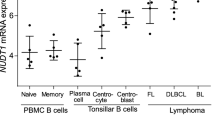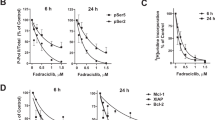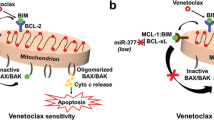Abstract
More than 50% of adults and ∼20% of children with pre-B acute lymphoblastic leukemia (ALL) relapse following treatment. Dismal outcomes for patients with relapsed or refractory disease mandate novel approaches to therapy. We have previously shown that the combination of the mTOR inhibitor RAD001 (everolimus) and the chemotherapeutic agent vincristine increases the survival of non-obese diabetic/severe combined immuno-deficient (NOD/SCID) mice bearing human ALL xenografts. We have also shown that 16 μM RAD001 synergized with agents that cause DNA damage or microtubule disruption in pre-B ALL cells in vitro. Here, we demonstrate that RAD001 has dose-dependent effects on the cell cycle in ALL cells, with 1.5 μM RAD001 inhibiting pRb, Ki67 and PCNA expression and increasing G0/1 cell cycle arrest, whereas 16 μM RAD001 increases pRb, cyclin D1, Ki67 and PCNA, with no evidence of an accumulation of cells in G0/1. Transition from G2 into mitosis was promoted by 16 μM RAD001 with reduced phosphorylation of cdc2 in cells with 4 N DNA content. However, 16 μM RAD001 preferentially induced cell death in cells undergoing mitosis. When combined with vincristine, 16 μM RAD001 reduced the vincristine-induced accumulation of cells in mitosis, probably as a result of increased death in this population. Although 16 μM RAD001 weakly activated Chk1 and Chk2, it suppressed strong vincristine-induced activation of these cell cycle checkpoint regulators. We conclude that RAD001 enhances chemosensitivity at least in part through suppression of cell cycle checkpoint regulation in response to vincristine and increased progression from G2 into mitosis.
This is a preview of subscription content, access via your institution
Access options
Subscribe to this journal
Receive 50 print issues and online access
$259.00 per year
only $5.18 per issue
Buy this article
- Purchase on Springer Link
- Instant access to full article PDF
Prices may be subject to local taxes which are calculated during checkout






Similar content being viewed by others
References
Silverman LB, Stevenson KE, O'Brien JE, Asselin BL, Barr RD, Clavell L et al. Long-term results of Dana-Farber Cancer Institute ALL Consortium protocols for children with newly diagnosed acute lymphoblastic leukemia (1985–2000). Leukemia 2009; 24: 320–334.
Moricke A, Zimmermann M, Reiter A, Henze G, Schrauder A, Gadner H et al. Long-term results of five consecutive trials in childhood acute lymphoblastic leukemia performed by the ALL-BFM study group from 1981 to 2000. Leukemia 2010; 24: 265–284.
Gokbuget N, Hoelzer D . Treatment of adult acute lymphoblastic leukemia. Semin Hematol 2009; 46: 64–75.
Nguyen K, Devidas M, Cheng S, La M, Raetz E, Carroll W et al. Factors influencing survival after relapse from acute lymphoblastic leukemia: a Children's Oncology Group study. Leukemia 2008; 22: 2142–2150.
Tavernier E, Boiron J, Huguet F, Bradstock K, Vey N, Kovacsovics T et al. Outcome of treatment after first relapse in adults with acute lymphoblastic leukemia initially treated by the LALA-94 trial. Leukemia 2007; 21: 1907–1914.
Crazzolara R, Cisterne A, Thien M, Hewson J, Baraz R, Bradstock KF et al. Potentiating effects of RAD001 (everolimus) on vincristine therapy in childhood acute lymphoblastic leukemia. Blood 2009; 113: 3297–3306.
Avellino R, Romano S, Parasole R, Bisogni R, Lamberti A, Poggi V et al. Rapamycin stimulates apoptosis of childhood acute lymphoblastic leukemia cells. Blood 2005; 106: 1400–1406.
Crazzolara R, Bradstock KF, Bendall LJ . RAD001 (everolimus) induces autophagy in acute lymphoblastic leukemia. Autophagy 2009; 5: 727–728.
Grünwald V, DeGraffenried L, Russel D, Friedrichs W, Ray R, Hidalgo M . Inhibitors of mTOR reverse doxorubicin resistance conferred by PTEN status in prostate cancer cells. Cancer Res 2002; 62: 6141–6145.
Teachey D, Sheen C, Hall J, Ryan T, Brown V, Fish J et al. mTOR inhibitors are synergistic with methotrexate: an effective combination to treat acute lymphoblastic leukemia. Blood 2008; 112: 2020–2023.
Blajeski AL, Phan VA, Kottke TJ, Kaufmann SH . G(1) and G(2) cell-cycle arrest following microtubule depolymerization in human breast cancer cells. J Clin Invest 2002; 110: 91–99.
Hawkins DS, Demers GW, Galloway DA . Inactivation of p53 enhances sensitivity to multiple chemotherapeutic agents. Cancer Res 1996; 56: 892–898.
Harper JW, Elledge SJ . The DNA damage response: ten years after. Mol Cell 2007; 28: 739–745.
Wanner K, Hipp S, Oelsner M, Ringshausen I, Bogner C, Peschel C et al. Mammalian target of rapamycin inhibition induces cell cycle arrest in diffuse large B cell lymphoma (DLBCL) cells and sensitises DLBCL cells to rituximab. Br J Haematol 2006; 134: 475–484.
Mabuchi S, Altomare D, Cheung M, Zhang L, Poulikakos P, Hensley H et al. RAD001 inhibits human ovarian cancer cell proliferation, enhances cisplatin-induced apoptosis, and prolongs survival in an ovarian cancer model. Clin Cancer Res 2007; 13: 4261–4270.
Saunders P, Cisterne A, Weiss J, Bradstock KF, Bendall LJ . The mammalian target of rapamycin inhibitor RAD001 (everolimus) synergizes with chemotherapeutic agents, ionizing radiation and proteasome inhibitors in pre-B acute lymphocytic leukemia. Haematologica 2011; 96: 69–77.
Branzei D, Foiani M . Maintaining genome stability at the replication fork. Nat Rev Mol Cell Biol 2010; 11: 208–219.
Morice WG, Brunn GJ, Wiederrecht G, Siekierka JJ, Abraham RT . Rapamycin-induced inhibition of p34cdc2 kinase activation is associated with G1/S-phase growth arrest in T lymphocytes. J Biol Chem 1993; 268: 3734–3738.
Law M, Forrester E, Chytil A, Corsino P, Green G, Davis B et al. Rapamycin disrupts cyclin/cyclin-dependent kinase/p21/proliferating cell nuclear antigen complexes and cyclin D1 reverses rapamycin action by stabilizing these complexes. Cancer Res 2006; 66: 1070–1080.
Haritunians T, Mori A, O'Kelly J, Luong Q, Giles F, Koeffler H . Antiproliferative activity of RAD001 (everolimus) as a single agent and combined with other agents in mantle cell lymphoma. Leukemia 2007; 21: 333–339.
Gao N, Zhang Z, Jiang B, Shi X . Role of PI3K/AKT/mTOR signaling in the cell cycle progression of human prostate cancer. Biochem Biophys Res Commun 2003; 310: 1124–1132.
Gao N, Flynn D, Zhang Z, Zhong X, Walker V, Liu K et al. G1 cell cycle progression and the expression of G1 cyclins are regulated by PI3K/AKT/mTOR/p70S6K1 signaling in human ovarian cancer cells. Am J Physiol Cell Physiol 2004; 287: C281–C291.
Peponi E, Drakos E, Reyes G, Leventaki V, Rassidakis G, Medeiros L . Activation of mammalian target of rapamycin signaling promotes cell cycle progression and protects cells from apoptosis in mantle cell lymphoma. Am J Pathol 2006; 169: 2171–2180.
Segurado M, Tercero JA . The S-phase checkpoint: targeting the replication fork. Biol Cell 2009; 101: 617–627.
Petersen J, Nurse P . TOR signalling regulates mitotic commitment through the stress MAP kinase pathway and the Polo and Cdc2 kinases. Nat Cell Biol 2007; 9: 1263–1272.
Wu MY, Cully M, Andersen D, Leevers SJ . Insulin delays the progression of Drosophila cells through G2/M by activating the dTOR/dRaptor complex. EMBO J 2007; 26: 371–379.
Ehrhardt H, Schrembs D, Moritz C, Wachter F, Haldar S, Graubner U et al. Optimized anti-tumor effects of anthracyclines plus vinca alkaloids using a novel, mechanism-based application schedule. Blood 2011; 118: 6123–6131.
Ito D, Matsumoto T . Molecular mechanisms and function of the spindle checkpoint, a guardian of the chromosome stability. Adv Exp Med Biol 2010; 676: 15–26.
Portugal J, Mansilla S, Bataller M . Mechanisms of drug-induced mitotic catastrophe in cancer cells. Curr Pharm Des 2010; 16: 69–78.
Peterson RT, Desai BN, Hardwick JS, Schreiber SL . Protein phosphatase 2A interacts with the 70-kDa S6 kinase and is activated by inhibition of FKBP12-rapamycinassociated protein. Proc Natl Acad Sci USA 1999; 96: 4438–4442.
Peng A, Maller JL . Serine/threonine phosphatases in the DNA damage response and cancer. Oncogene 2010; 29: 5977–5988.
Su WC, Liu WL, Cheng CW, Chou YB, Hung KH, Huang WH et al. Ribavirin enhances interferon signaling via stimulation of mTOR and p53 activities. FEBS Lett 2009; 583: 2793–2798.
Song J, Salek-Ardakani S, So T, Croft M . The kinases aurora B and mTOR regulate the G1-S cell cycle progression of T lymphocytes. Nat Immunol 2007; 8: 64–73.
Yang C, Tang X, Guo X, Niikura Y, Kitagawa K, Cui K et al. Aurora-B mediated ATM serine 1403 phosphorylation is required for mitotic ATM activation and the spindle checkpoint. Mol Cell 2011; 44: 597–608.
Castedo M, Perfettini JL, Roumier T, Valent A, Raslova H, Yakushijin K et al. Mitotic catastrophe constitutes a special case of apoptosis whose suppression entails aneuploidy. Oncogene 2004; 23: 4362–4370.
Bendall LJ, Kortlepel K, Gottlieb DJ . Human acute myeloid leukemia cells bind to bone marrow stroma via a combination of beta 1 and beta 2 integrin mechanisms. Blood 1993; 82: 3125–3132.
Bradstock K, Bianchi A, Makrynikola V, Filshie R, Gottlieb D . Long-term survival and proliferation of precursor-B acute lymphoblastic leukemia cells on human bone marrow stroma. Leukemia 1996; 10: 813–820.
Juarez J, Bradstock K, Gottlieb D, Bendall L . Effects of inhibitors of the chemokine receptor CXCR4 on acute lymphoblastic leukemia cells in vitro. Leukemia 2003; 17: 1294–1300.
Acknowledgements
RAD001 (everolimus) was kindly provided by Novartis. This work was supported by a University of Sydney Postgraduate Award (PS), NHMRC CDA2 No.511965 (LB) and project grant no. 352326 (RB, JW), and the Leukemia and Lymphoma Society Translational Program grant no. 6105-08 (RW).
Author information
Authors and Affiliations
Corresponding author
Ethics declarations
Competing interests
The authors declare no conflict of interest.
Additional information
Supplementary Information accompanies the paper on the Oncogene website
Supplementary information
Rights and permissions
About this article
Cite this article
Saunders, P., Weiss, J., Welschinger, R. et al. RAD001 (everolimus) induces dose-dependent changes to cell cycle regulation and modifies the cell cycle response to vincristine. Oncogene 32, 4789–4797 (2013). https://doi.org/10.1038/onc.2012.498
Received:
Revised:
Accepted:
Published:
Issue Date:
DOI: https://doi.org/10.1038/onc.2012.498



